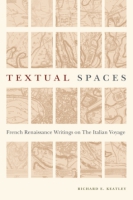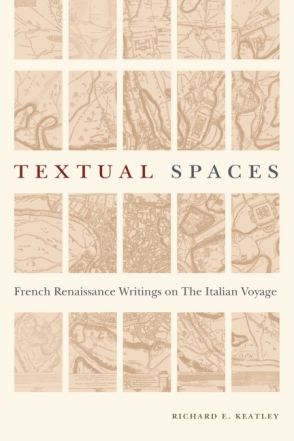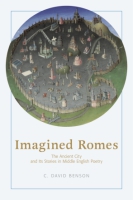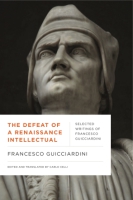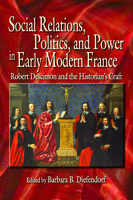Textual Spaces
French Renaissance Writings on the Italian Voyage
Richard E. Keatley
“Textual Spaces is the product of patient, sound, and thorough scholarship that mobilizes a wealth of source material to paint a vivid picture of the careerism, culture, and curiosity of early modern French travelers to Italy. Keatley has made an original and important contribution to the field of Renaissance studies and to the subfield of travel studies.”
- Description
- Reviews
- Bio
- Table of Contents
- Sample Chapters
- Subjects
Utilizing period maps and geographical sources, Keatley combines rigorous philological mapping of travelers’ itineraries with creative analyses of the tensions that undergird the rewriting of space. He examines a vast corpus of texts that includes Michel de Montaigne's Journal de voyage, Joachim du Bellay’s Regrets, and Jacques de Villamont’s Voyages as well as lesser-known and anonymous travel accounts of the French experience in Italy. In his readings, Keatley traces how the creation of these “textual spaces” allowed travelers to transform territories lost to France through warfare into spaces of desire, forming what Pierre Bourdieu calls symbolic capital, which was used in an ongoing commerce within the French political landscape.
By highlighting the political and militaristic origins of leisure excursions, Textual Spaces contributes to our understanding of travel’s dual nature and invites the modern reader to examine the exploitative origins of tourism. Linking the fields of literary and cultural studies, history and art history, and spatial and landscape theory, it provides an engaging vision into the early history of travel that will interest historians, literary scholars, and anyone keen to understand why we venture abroad.
“Textual Spaces is the product of patient, sound, and thorough scholarship that mobilizes a wealth of source material to paint a vivid picture of the careerism, culture, and curiosity of early modern French travelers to Italy. Keatley has made an original and important contribution to the field of Renaissance studies and to the subfield of travel studies.”
“This study illuminates early French travels to Italy from a myriad of angles: linguistic, political, historical, biographical, medical, and architectural. At the same time, it explores outward, linking historical materials to questions of leisure, militarism, and global tourism. Advancing the notion of ‘performed leisure,’ Keatley smartly situates French travel within a rich context of political, social, economic, and learned textual impulses. His study of Montaigne’s voyage, in particular, proves a tour de force.”
“Textual Spaces is a valuable resource for readers interested in a wide variety of aspects of the Renaissance—literary, art historical, and broadly cultural. It will surely stimulate and facilitate further research in its field.”
Richard E. Keatley is an independent scholar from Tucker, Georgia.
Contents
Acknowledgments
Introduction
1. Montaigne Inside and Out
2. Textuality, Sexuality, and Political Geography: André de la Vigne and the French Conquest of Naples
3. Space, Travel, and Work
4. The Topographical Narrative
5. Spaces and Places of the Voyage d’Italie
6. Mapping Montaigne’s Rome
Conclusions
Notes
Bibliography
Index
From the Introduction
In the spring of 1589, a young French traveler, nearing the end of his year long journey through Italy and arriving in the remote Christian outpost of Malta, found his surprise visit was somewhat suspect. His crossing from the mainland had been adventuresome. He sailed in a Spanish galleon from Naples to Messina, singing on deck with the sailors and arriving in the great trading city of Palermo. From there he took a felucca, one of the small, single-sailed vessels that worked the coasts of southern Italy, sailing back to Messina and down Sicily’s eastern coast. He describes shores plagued by pirates and backed by a hostile, symbolic landscape, skirting the mythical traps of Scylla and Charybdis (Straits of Messina) and sailing past black, amorphous, ashen stones belched from the mouth of the formidable “Mont Gibel” (Etna). After brief stops in Catania and Syracuse, his vessel followed the sparsely inhabited coast of the southern part of the island. They overnighted in caves “creusees d’impétuosité de mer, dans lesquelles se peuvent cacher les galliotes turcquesques qui coustumierement attendent les vaisseaux des passans d’un cotté ou d’aultre” (carved out by the sea’s force, where Turkish corsairs can hide awaiting vessels that pass through in either direction). Delayed by contrary winds and followed by a suspicious ship they managed to keep at a distance, the traveler and his companion finally arrived “saintz et sauvés (sic)” (safe and sound, or sainted and saved)1 on April 13, 1589, where they were quickly brought to meet the Grand Master of the Order of the Knights of Malta, Cardinal Hugues de Loubenx de Verdalle.2 When asked the purpose of their visit, our traveler responded with words that had become a leitmotif of his journey up to that point; he replied that he had been driven to this remote location by “le seul desir de voir l’isle et la bonne compagnie qui y estoit” (139) (the sole desire to see the island and the good company that was there). Verdalle welcomed the visitors and invited them to stay as long as they liked but later summoned our anonymous traveler to his chambers to ask him yet again what he was doing there and if he had any message from the king, to which our traveler “faict la mesme response” (gave the same answer).Verdalle’s questioning underscores the ambiguous status of Renaissance travelers, whose political profiles are often masked by pleasant ramblings through Italy in the pursuit of the “desir de voir” (desire to see things). Traveling as official or unofficial representatives of the government or working for high-ranking patrons, these travelers are called upon to navigate a network of sociopolitical influence in which the issues of national, religious, and personal identity all come into play. Like the explorers of the New World, travelers to Italy embody the social, political, and religious tensions of their countries of origin. They practice and learn the art of politics and study law in the universities of Padua, Pavia, Ferrara, and Bologna or the arts of horsemanship and fencing needed for members of the soldierly class. At the same time, the narratives, poems, and descriptions that emerge from this political experience generally give short shrift to these practical concerns, preferring, like the author of the anonymous Discours viatiques, to narrate their adventures; record archaeological, architectural, and anthropological singularities; and wander for the “desir de voir.” The political content of the narrative of travel to Italy thus acts as a disguised motor of aesthetic production, lying in the background of an experience expressed in literary terms and modeled on forms of textual production. Literary form thus communicates the inherently metaphorical, metaphysical aspects of travel in a larger sense, one that reflects a personalized mythos embedded deep within the traveler’s psyche.Philippe Desan has recently described the relationship between Michel de Montaigne’s lifelong engagement with politics and the writing of the Essais. Among other things, Desan illustrates the important role Montaigne’s Italian journey played in Henri III’s jockeying for power with Pope Gregory XIII. These considerations provide social and political context for the writing of the 1582 edition of the Essais, but more importantly, they explore the links between Montaigne’s aesthetic and literary activity and his politics, building on George Hoffmann’s analysis of the intersections between Montaigne’s practice of writing and his public career. If the Essais elicit questions regarding the relationship between public and private modes of expression, the Journal de voyage exacerbates many of these same problems due to its apparent lack of concern for the politics. Whether written as a private notebook or addressed, like the Discours viatiques, to an intimate friend, the travel account, like the Essais, creates a private space within the public square of literary expression, an “arriere-boutique” of intellectual and aesthetic interrogation whose relationship to political action is difficult to define due to its repressed nature.The War over Spaces: French and Italian Wars in the Sixteenth CenturyThis book examines how political, social, and economic concerns come to bear on the aesthetics of literary production. We will see that Renaissance travelers’ expressed escapism and that their gluttony for space and experience appear as expressions of a performed leisure in the sense studied by Virginia Krause, using contact with the cultural spaces of Italy as a form of symbolic capital whose resonances are inherently sociopolitical. The examination of antiquity, analysis of the structures of Italy’s modern cities, and wandering toward unnamed, undiscovered lands stem from the tastes and representational needs of a social class whose behavioral models skirt the borders between traditional, chivalric models of behavior and the demonstration of the intellectual, social, and political ability needed to get promoted. Crossing mountains, tracing the steps of Cicero, and sounding the depths of volcanic caves in the pursuit of curiosity become rhetorical performances within the political context of late sixteenth-century France and its ongoing contentious relationship with Italy.France’s engagement in Italy began calamitously in 1494 with Charles VIII’s attempt to wrest the Neapolitan throne from King Ferrante d’Aragona and ended sixty-five years later with the French renunciation of its territorial claims in Italy with the signing of the Treaty of Cateau-Cambrésis. During this period, France’s kings and nobility often focused their attention more on their neighbor to the south than on affairs at home. The Italian Wars not only served as a training ground for the nobility, offering the chance to serve one’s country, but also led to the importation of the technology and culture of Renaissance Italy into France. While the French conquests in Italy were doomed to be ephemeral, as the Italian historiographer Marino Sanudo boasted, the impact of the sixty-year engagement on the technology, culture, and politics of France was profound and long-lasting.Travelers to Italy after the signing of the Treaty of Cateau-Cambrésis thus moved through an altered political landscape in which French influence had been replaced by that of a global Spanish Empire. French travelers’ perceptions were often influenced by the particular political circumstances of the states they visited: positive in cities with strong French sympathies, such as Ferrara or Siena, nostalgic or critical in places where Spanish control had replaced French influence. More often than not, however, French travelers learned to navigate a new, increasingly complex reality, such as in Turin, where a highly strategic marriage guaranteed pro-French sentiment while the city itself recalled France’s defeat at the hand of Duke Emmanuel-Philibert (reigned 1553–80). Much of the rest of Italy had become a Spanish protectorate, with the kingdom of Naples and the coastal states of the Presidio outright Spanish possessions. The Duchies of Milan, Republic of Genoa, all objectives, at one time or another, of the expansionist aspirations of the French monarchy, were now, like Mantua, the Grand Duchy of Tuscany, and the Republics of Lucca and Genoa, under Spanish protection or control.These smoldering political tensions, fueled by the historic cultural relationship between French and Italian culture, helped transform Italy’s cities and territories, once the object of explicit territorial ambitions, into spaces of desire, where nostalgic rumination and aesthetic memory are elaborated in interesting ways.The Spatial (Textual) DiscourseIf the political and national implications of geographical space are apparent, the translation of the individual’s experience into a coherent discourse is less straightforward. Space is subjective, embodying political, economic, and social values that are then interpreted by the viewer. The psychological, historical, and political factors that make up the “accidental whole” of perceived space are thus reexpressed in what Henri Lefebvre calls “created space.” At the same time, the geopolitical spaces of Renaissance Italy are themselves textually determined so that the traveler, prepared through reading and research, comes to interrogate the textual spaces, adding vision and firsthand experience to his humanistic preparation conducted through reading. The travel narrative thus pits the textual culture of Renaissance humanism against the practical, lived approach of an emerging spatial discourse characteristic of the age of geographical discovery, challenging and negotiating what Numa Broc calls a “textualized” image of the world. The “weight of the library” evident in the description of the New World and Middle East reaches a point of paroxysm in the writing of Italy.19 The use of an antiquarian lens to describe space, characteristic of the humanistic reading of geography as the theater of history, marks the French vision of Italy with the anachronism of looking at one thing while imagining another and anticipates the Orientalist view in which the visualized present is seen as the sign of an incipient absence. The need to annex the Italian landscape into the French identity thus leads to the creation of a heterotopic space, transforming spatial discourse into a means for expressing French national interests. Textual authority provides the illusion of coherence, correcting the cognitive dissonance of visual recognition while deferring meaning in a game of infinite textual referencing. The omnipresent emphasis of vision in the Renaissance travel narrative can thus be seen as an attempt to overcompensate for a lack of access to visual documentation. At the same time, literary representation problematizes the iconicity of spatial citation by appropriating personal experience into discourse centered on the traveler. More so, perhaps, than the exploration of terrae incognitae, travel through the “known” spaces of Italy forces a confrontation between words and reality.Scope and Organization of This StudyThis book begins and ends with an analysis of two moments in Michel de Montaigne’s journey through Italy as represented in his Journal de voyage. In both of these instances, we can see the complexity of Montaigne’s thoughts regarding Italian spaces, his French homeland and fellow countrymen, and the intersection between public service and personal enjoyment of travel. As Montaigne enters Italy after a pleasant stay in what he calls “Germany,” we see how his longings for “other” spaces are fueled by conflicting thoughts of his homeland and of his unannounced purpose in Rome. The Alpine passage also marks Montaigne’s entry as an active voice in the discourse of the Journal, whose narrative was maintained by a personal secretary. Montaigne’s vision of travel is indicative of his class and political status, while the voice of his servant, alert and trained in the art of mimetic and political representation, seconds and helps construct his master’s self-image.My next two chapters deal with two examples of secretarial writing of the French experience of the Italian Wars. André de la Vigne’s Voyage de Naples and La Ressource de la Chrestienté, written at the opening of the Italian Wars, use topographical, allegorical, and poetic space to justify Charles VIII’s plan to take Naples and glorify the king’s actions while in Italy. La Vigne’s techniques range from the allegorical use of sex to represent landscape to the bombastic use of the poetic arsenal of the grands rhetoriqueurs to replicate the spatial order of battle. La Vigne is also an early example of authorial self-assertion in the age of printing. His writing of the spaces of official discourse, moreover, contributes to and conditions his own assertion of self-identity. Sixty years later, Joachim Du Bellay subverts the secretary’s voice in his bitterly sarcastic “vers secretaires.” Written as French aspirations to an ultramontane empire come to a close, Du Bellay’s Regrets describes courtly intrigue, dissemblance, and moral debauchery, reflecting an evolution not only in the French engagement in Italy but also in how the author uses the Italian journey to stage a version of himself. By concentrating on the narrative elements of the Regrets, including the sometimes neglected sonnets courtisans, this chapter shows how the spatial narrative redirects Du Bellay’s satirical Roman lament back onto the French political scene, transforming the voyage de Rome into a voyage d’Italie and positing Du Bellay as an experienced court servant.[Excerpt ends here.]
Mailing List
Subscribe to our mailing list and be notified about new titles, journals and catalogs.
